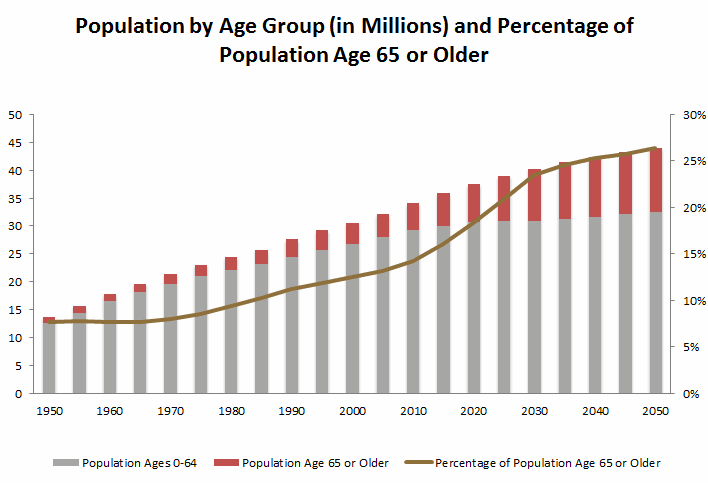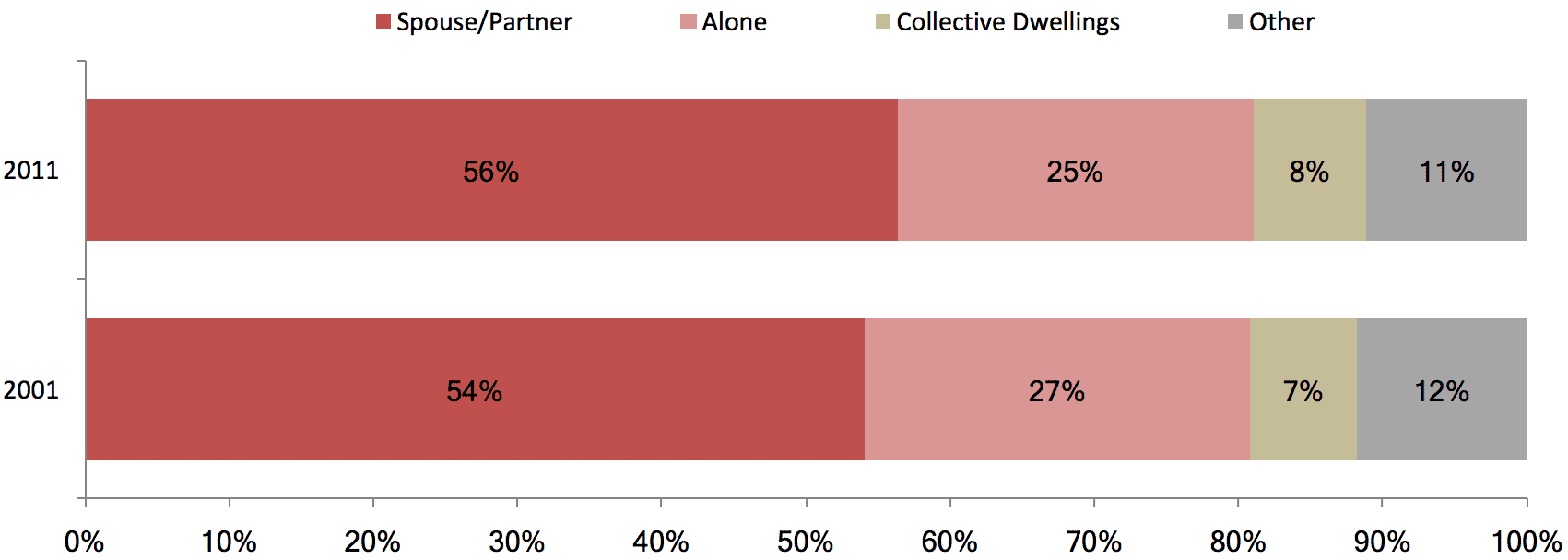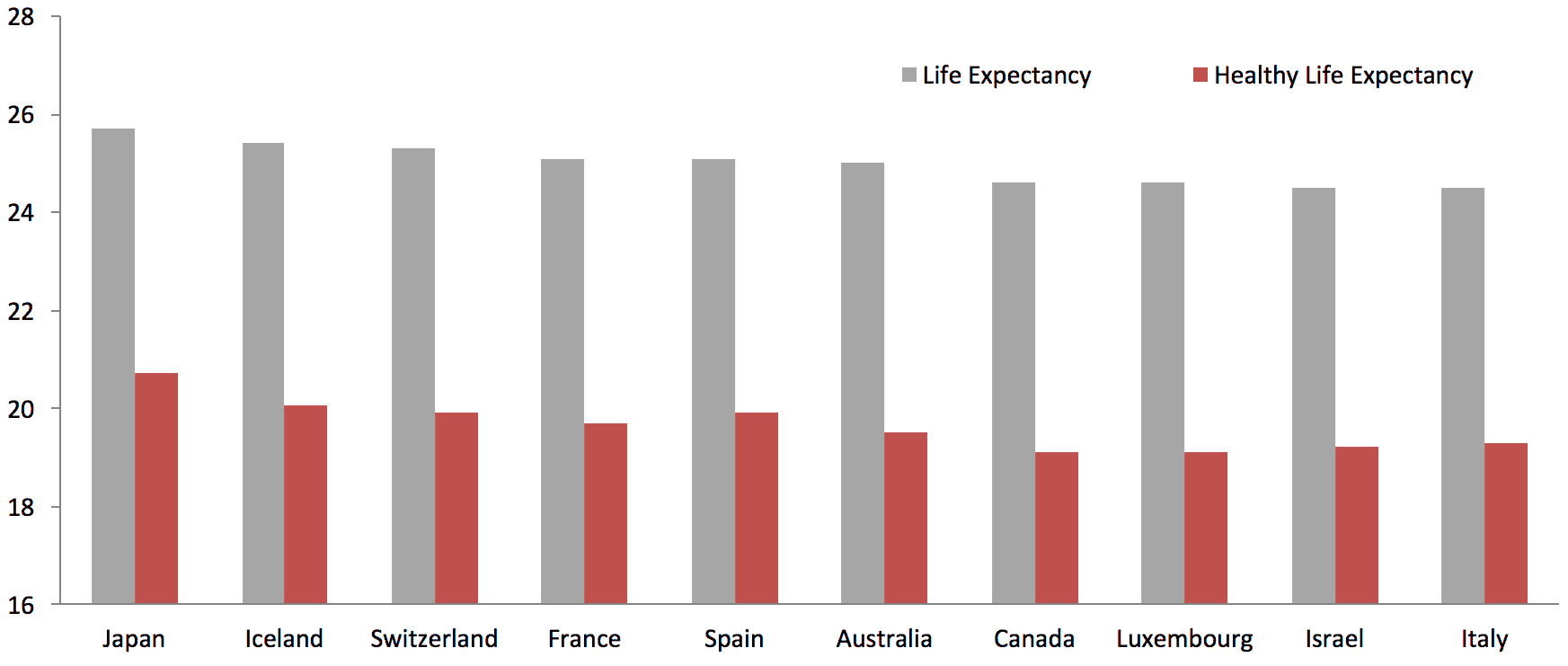In 2015, for the first time, Canadians age 65 and older outnumbered those younger than 15. Even though older adults make up a smaller share of the population in Canada than in many OECD countries, the growth of this segment has dramatically outpaced that of the general population every year since 2011, when the post-World War II baby boomers started to turn 65. By 2026, Canada is expected to become a “super-aged” society as the share of people age 65 and older will exceed 21 percent of the total population.
Coupled with the aging population is the slowing growth of Canada’s workforce, which could threaten the country’s long-term prosperity. As a result, the government has made it a priority to encourage the labor participation of all adults, including older workers, through national programs that have effectively helped with job placement for older unemployed workers. Older Canadians’ economic engagement is also being facilitated by their greater digital aptitude than that of their counterparts in many other OECD countries, partly thanks to efforts made by the federal and provincial governments, as well as community and non-profit organizations, to narrow the digital divide. Both the public and private sectors have also stepped up efforts to develop and commercialize digital products and solutions that meet the needs of older adults.
Social connection among older Canadians is strengthened by the government’s effort to advance community social and home-based care, aimed at supporting healthy, independent aging while also helping to relieve pressure on the country’s hospital system. While some longstanding national campaigns have been in place to fund community-based projects, governments have more recently strengthened financial support to family caregivers through tax credits and allowances.

Canada’s population age 65 and older is projected to double from 2015 through 2050, while the population of ages from 0 through 64 is projected to increase just 8 percent. Over the same period, the share of the older population will rise from 16 percent to 26 percent of the total population.
Source: UN Population Division

Community Social Infrastructure
The majority of older Canadians live independently in their communities, with a higher degree of social connection than their counterparts in most OECD countries. This is partly a result of efforts made by the Canadian government, at both the federal and local levels, to promote age-friendly communities and to fund community-based projects that are tailored to local needs. Accessibility to public transportation and facilities falls short, partly due to the absence of relevant national legislation.
Living Arrangements of Adults Age 65 and Older

More than 92 percent of those age 65 and older live in private households rather than in collective dwellings such as nursing homes, and 81 percent live either alone or with a spouse. While this percentage has been relatively stable since the 2000s, the share of those who live alone has declined slightly due to improvements in the life expectancy of men.
Source: Statistics Canada 2015
The New Horizons for Seniors Program
The New Horizons for Seniors Program (NHSP) is the main platform used by the Canadian federal government to fund local projects to help older adults benefit from, and contribute to, the quality of life in their communities. First introduced in 2004, NHSP funds projects run by various stakeholders, including, but not limited to, municipal governments, non-profit organizations, community organizations, health and care service institutions, and research institutes. Recipient projects often focus on supporting social participation and inclusion, promoting volunteerism, and preventing elder abuse. Since its inception, the NHSP has funded close to 17,800 projects in hundreds of communities nationwide, with a total investment of more than CAD 360 million (approximately USD 264 million). One program that recently received funding from NHSP is the Welcoming Seniors’ Space, launched by the South Burnaby Neighbourhood House society in Vancouver in 2016. The program aims to build senior sites in eight linguistically diverse neighborhoods in the city, targeting those who are age 75 and older and facing language or cultural barriers. Volunteers will communicate with visiting older adults in their mother language, helping to connect them to appropriate services and organize social events to promote their social engagement. The program has received CAD 500,196 (approximately USD 366,323) from the NHSP for its first three years of operation.
Productive Opportunity
Canada has seen a deceleration in its workforce growth over the past decade, with the trend expected to continue as the baby boom generation retires. In response, the government has placed greater emphasis on broadening the labor force participation of all citizens, including older people. However, the transition from the Harper administration, which favored fiscal conservatism, to the more liberal Trudeau administration, which is prioritizing increased public spending and social supports, has resulted in a different policy direction with respect to older workers. The change is evidenced in the Trudeau administration’s decision to cancel a planned increase in the pensionable age of the basic Old Age Security to 67 in 2023, citing the importance of protecting vulnerable seniors. Instead, the new administration has stated its intention to increase incentives for those who are willing and able to remain in the labor force.
The average annual growth rate of Canada’s workforce from 2006 through 2015, 1.1 percent, was two-thirds lower than in the previous decade. Statistics Canada projects that this will fall to 0.5 percent per year in the 2020s, resulting in real economic growth below 2 percent annually from 2015 through 2025.
The Targeted Initiative for Older Workers
The federal government launched the Targeted Initiative for Older Workers (TIOW) program in 2007 to help improve older adults’ employability and reintegrate them into the labor market. Since its inception, 417 TIOW projects have been approved, targeting over 32,230 unemployed older workers in communities across the country. In 2014, the Conservative government renewed the TIOW for a three-year period, representing an additional federal investment of CAD 75 million (approximately USD 55 million). The TIOW program provides skills training in a range of areas, including job research, résumé writing, interview techniques, informational interviewing, and basic computer skills. The Trudeau administration decided not to renew the TIOW program after the funding terminated in March 2017. Instead, it will combine TIOW with another two existing initiatives – the Canada Jobs Fund and the Labour Market Agreement for Persons with Disabilities – into a new Workforce Development Agreement to ensure people’s continued access to support for job placement. The consolidation of these programs is intended to streamline the funding transfers and improve effectiveness, as beneficiaries of these initiatives often fall under multiple categories. The government is planning to invest CAD 900 million (approximately USD 659 million) in this new program over the next six years.
“The TIOW program has the additional benefit of bringing older workers together and offers participants the opportunity to share their experiences being unemployed and discouraged, either in groups or through one-on-one assistance, which helps to provide mental support to older jobseekers and is not often available in other employment support programs.”
– Joe Mancini, Director, The Working Centre Kitchener-Waterloo-Cambridge

Technological Engagement
Older Canadians are increasingly integrating information and communication technologies (ICT) into their daily lives with the support of community-led programs focused on skills development. In recent years, both the government and the private sector have stepped up efforts to support the development and commercialization of digital products and solutions that meet the needs of older adults and caregivers, with some success, particularly in the healthcare sector.
“Older people tend to have some resistance when first introduced to the technology; but once they recognize the benefit, particularly of technology that is very easy to use and adaptable, they are very eager to use the devices and services that improve comfort and quality of life.”
– Azi Boloorchi, Director of Innovative and Strategic Partnerships, Revera
In 2000, only 11 percent of respondents ages 65 through 74 reported in a 2000 survey that they had used the Internet in the previous 12 months. By 2010, 60 percent of respondents of the same age group reported that they had used the Internet in the previous three months.
AGE-WELL Network
The federal government launched the AGE-WELL Network (Aging Gracefully across Environments Using Technology to Support Wellness, Engagement and Long Life NCE Inc.) in 2015 to build upon emerging and advanced technologies such as artificial intelligence, e-health, ICTs, and mobile technologies to create products and services that benefit older adults and caregivers. AGE-WELL has a CAD 36.6 million (approximately USD 26.8 million) fund, which will be deployed between 2015 and 2020. Adopting a multi-pronged model to accomplish its objectives, AGE-WELL covers the entire spectrum of research and development, commercialization, and knowledge transfer. It provides funding for world-class research in technologies for healthy aging; provides training and workshops on assistive technologies; and connects researchers with public-private-sector stakeholders focused on commercialization. It has provided funding and learning opportunities for more than 200 emerging researchers in technology and aging since its establishment.
In 2016 and 2017, AGE-WELL’s Strategic Investment Program (SIP) is supporting three new start-ups focused specifically on aging and caregiving: Winterlight Labs, a company that is commercializing a tablet-based speech-assessment technology that can identify Alzheimer’s and Parkinson’s diseases with high accuracy; Braze Mobility, which is commercializing a system that can convert any commercial wheelchair into a smart wheelchair to prevent collisions; and Steadiwear Inc., which is commercializing a smart glove that reduces hand tremors. As part of the SIP, recipients receive from AGE-WELL up to CAD 25,000 (approximately USD 18,310) for one year.
Healthcare & Wellness
Canada is a global leader in longevity, although it has a larger gap between lifespan and healthspan than its peers. In light of the rising healthcare demand from an aging population and limitations on the healthcare system, both the federal and provincial governments have focused on supporting home-based care and increasing support for informal caregivers. Meanwhile, efforts are underway to improve the hospital environment so that it is friendly for older adults.
Top 10 Major Countries by Life Expectancy
(At Ages 60−64 As of 2015; in Years)

As of 2015, the life expectancy for Canadians ages 60 through 64 was 24.6 years. However, among the top 10 large countries that have the greatest longevity, Canada had the lowest healthy life expectancy for seniors ages 60 through 64, at 19.1 years as of 2015, leading to the largest gap between healthspan and lifespan − 5.5 years.
Source: Institute for Health Metrics and Evaluation
Approximately 5.4 million Canadians provided care to a senior family member or friend, accounting for 18 percent of the population age 15 and older. Informal caregivers are estimated to provide 66 to 84 percent of care to older adults, varying by province and territory.
CARERS Program
While the federal government has strengthened support for family caregivers through tax credits and allowances, certain projects have been undertaken on local levels to provide them with more training and emotional-support. One successful program is the Reitman Center Working CARERS program, launched by Mount Sinai Hospital (MSH) in Toronto in 2008. CARERS provides a ten-week small-group program that includes education, problem-solving therapy, and skills training by using simulation exercises. What makes it so effective is that the simulation phase includes live encounters with a typical patient in a real-life situation, so the caregiver can actually practice fundamental skills. Because it is relatively easy to implement and modify to specific cultural-religious requirements, the model has been adopted by several community care organizations in the Toronto area. Building on local successes, in June 2013, the government’s Social Development Partnerships Program gave MSH a CAD 2.84 million (approximately USD 2.08 million) grant to develop the first comprehensive program in Canada for supporting professional caregivers. The purpose of this grant is to scale this program across Canada through manuals and e-learning modules.